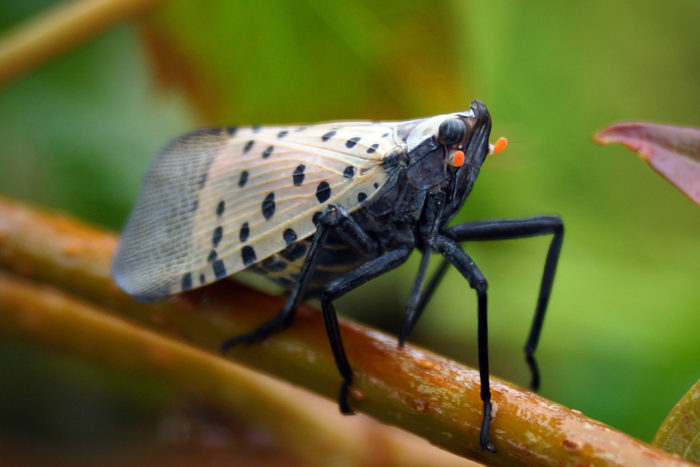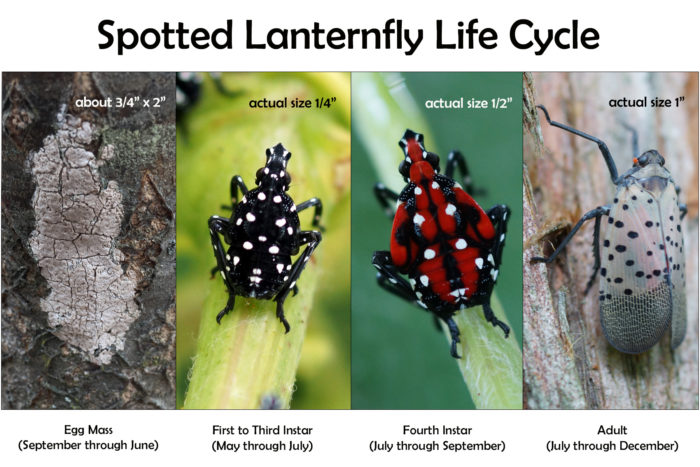
It’s big, it’s bad, and it could well be headed your way, if it’s not there already. First identified in the United States in Berks County, Pennsylvania, in 2014, spotted lanternfly (Lycorma delicatula) is now infesting much of Eastern Pennsylvania. Populations have also been found in Delaware, New Jersey, and Virginia, and adults and egg masses have been spotted in New York.
Native to parts of Asia, the spotted lanternfly is actually a planthopper, not a fly, with needlelike mouthparts that pierce plant stems and draw out sap. When the nymphs and adults feed in large numbers, as they tend to do, they seriously weaken plants. Grapes (Vitis spp. and cvs., Zones 3-10), hops (Humulus lupulus, Zones 4-8), and tree-of-heaven (Ailanthus altissima, Zones 4-8) are among the favored hosts, but this pest can feed on a wide range of woody and herbaceous plants and poses a significant threat to various aspects of the agriculture and forestry industries.
Spotted lanternflies pose major problems for home landscapes as well. Fortunately, they don’t bite or sting, so they don’t offer a direct threat to people or animals. Their feeding does draw nutrients away from plant growth, however, and the insects release large quantities of sticky “honeydew,” to the point where outdoor activities under infested trees can be extremely unpleasant. The sugary honeydew also encourages the development of black sooty mold, which discolors buildings, vehicles, paving, plants, and outdoor furniture and is difficult to remove completely.
What can you do about these pests? The biggest contribution you can make right now is to educate yourself about the spotted lanternfly life cycle and learn to identify this distinctive insect in its various stages—particularly the egg masses, which can easily be transported long distances on firewood, outdoor equipment, stone, and other materials. The nymphs and adults can also enter or cling to vehicles. Remove and destroy any eggs, nymphs, or adults you find.

It’s also critical to be aware of whether you live in a quarantined area, and to understand and comply with the quarantine guidelines if you do. Residents living in quarantined areas must complete and sign a checklist before moving outdoor items outside of the area, for example. You’ll also notice Pennsylvania business vehicles displaying orange permit hang tags or stickers. These permits indicate that the business has completed training and agreed to comply with the quarantine order. The permit does not indicate that the business is licensed to apply sprays or other control measures. Delaware and New Jersey also have permitting programs.

You can find a wealth of up-to-date information about identification, controls, quarantine issues, and FAQs at the Penn State Extension spotted lanternfly page and the Pennsylvania Department of Agriculture spotted lanternfly page. Outside of Pennsylvania, check out the USDA’s pest tracker page and your state’s Department of Agriculture website to find out the status of this pernicious pest where you live.
The spotted lanternfly is a serious issue, folks, and we gardeners have an important role to play in making our neighbors and communities aware of this insect, in hopes of slowing its spread far beyond our Mid-Atlantic region.
Nancy J. Ondra is the author of over fifteen books, including Grasses, The Perennial Care Manual, and The Perennial Matchmaker.


















Comments
There is an enormous infestation of the nymphs this spring in Northwest Philadelphia. They've been seen on rose bushes, clematis, new raspberry canes. Folks are wrapping tape - sticky side out - on tree trunks to kill thousands in a day.
That's terrible. Yes, they feed on such a large range of plants which makes them a major force to be reckoned with. Be sure to report any infestations you see to your extension office!
Log in or create an account to post a comment.
Sign up Log in